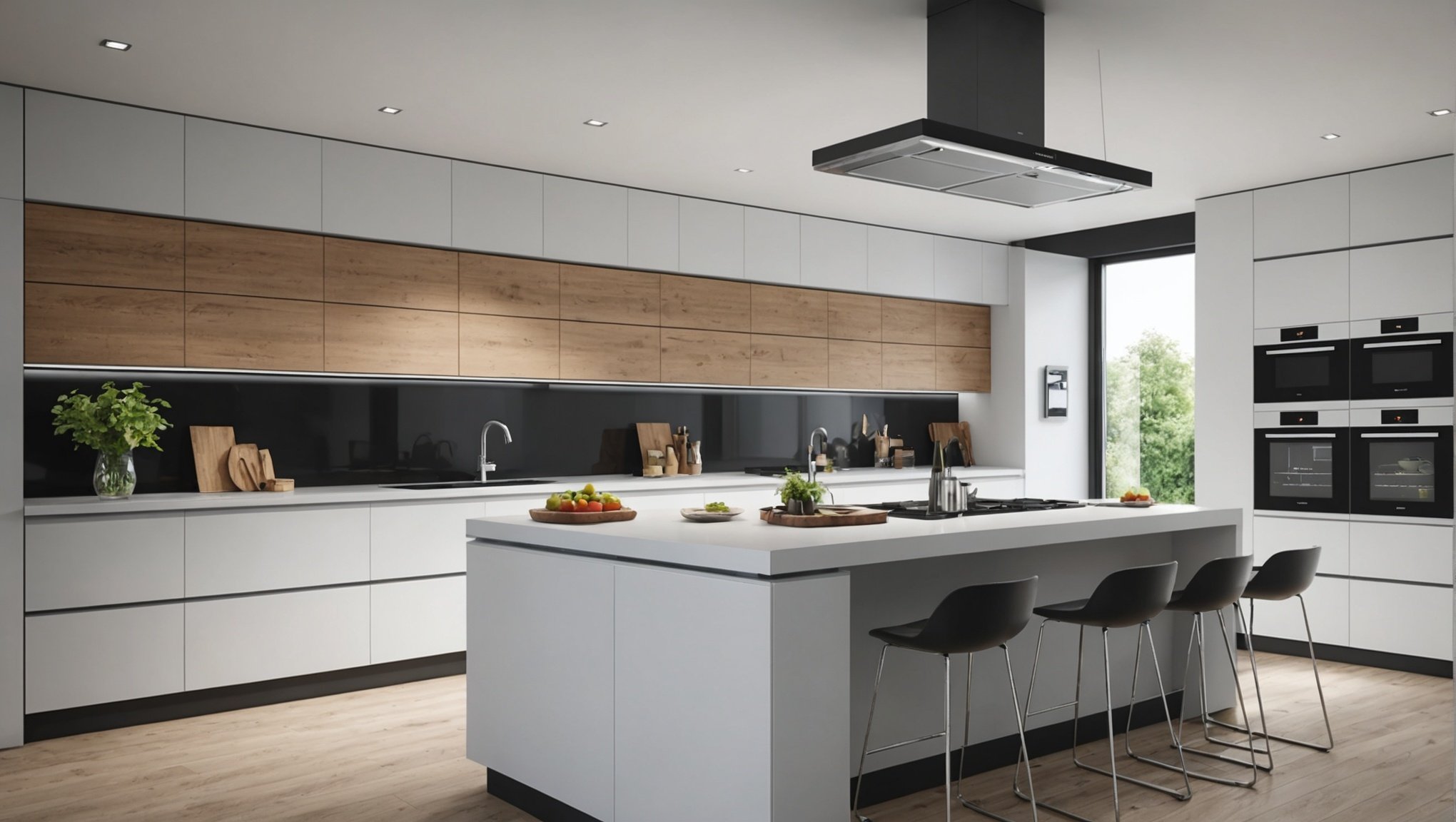Choosing the right kitchen extractor fan requires careful consideration of your space and cooking habits. An efficient fan safeguards air quality while enhancing your kitchen’s aesthetics. Factors such as size, noise level, and installation type play significant roles. Understanding these elements ensures optimal performance tailored to your unique environment. This guide will equip you with the knowledge to select the perfect extractor fan, elevating your kitchen experience while keeping it functional and stylish.
Understanding Kitchen Extractor Fans
Kitchen extractor fans are an essential component of ventilation systems, playing a crucial role in maintaining good air quality. In any kitchen, proper ventilation is vital to eliminate smoke, steam, and odours that arise during cooking. Without effective ventilation, these elements can accumulate, leading to poor indoor air quality and potential health issues.
Also to read : Maximizing Space: Innovative Tips for Adding a Foldable Dining Area to Your Tiny Kitchen
Extractor fans work by drawing out the contaminated air and expelling it outside, ensuring that fresh air circulates back into the kitchen. This process not only improves air quality but also helps in reducing moisture levels, which can prevent the growth of mould and mildew.
There are several types of kitchen extractor fans available, each designed to cater to different needs and kitchen layouts:
Also to read : Selecting the Perfect Kitchen Sink Size to Meet Your Family”s Needs
- Ducted extractor fans: These fans expel air directly outside through a duct, providing efficient and effective ventilation. They are ideal for larger kitchens where installation of ducts is feasible.
- Recirculating extractor fans: These fans filter the air and recirculate it back into the kitchen. They are suitable for spaces where duct installation is not possible.
- Integrated extractor fans: Often built into kitchen units, these fans offer a seamless look while providing necessary ventilation.
Choosing the right kitchen extractor fan depends on the specific requirements of your kitchen space and personal preferences.
Key Factors in Selecting an Extractor Fan
Choosing the right extractor fan for your kitchen involves several critical considerations, particularly concerning fan size and power requirements.
To begin, assess the size of your kitchen. This is crucial because the fan size should be proportional to the kitchen’s dimensions. A larger kitchen typically requires a more powerful extractor fan to ensure efficient air circulation. The fan’s size and capacity should match the room’s volume to effectively remove smoke, steam, and odours.
Next, determine the necessary extraction rate. This refers to the volume of air the fan can move, usually measured in cubic meters per hour (m³/h). A general guideline is that the extraction rate should be at least ten times the kitchen’s volume to maintain optimal air quality. For instance, a 30 m³ kitchen would need a fan with a minimum extraction rate of 300 m³/h.
Finally, consider the design and aesthetics of the extractor fan. It’s essential to select a fan that complements your kitchen’s style while meeting functional requirements. Integrated fans offer a sleek look, whereas decorative models can serve as a focal point. Balancing aesthetics with practicality ensures that your kitchen remains both beautiful and well-ventilated.
Types of Kitchen Extractor Fans
When choosing a kitchen extractor fan, understanding the types of extractor fans available can significantly impact your decision. Among the popular options are wall-mounted and ceiling-mounted fans, each offering distinct advantages.
Wall-Mounted Extractor Fans
Wall-mounted extractor fans are a common choice for many kitchens. Installed directly on the wall, these fans are ideal for kitchens with limited ceiling space. They are particularly effective in removing smoke and odours from cooking surfaces close to walls. Wall-mounted fans often come in various styles, allowing you to select one that suits your kitchen’s aesthetics while ensuring efficient ventilation.
Ceiling-Mounted Extractor Fans
For kitchens with more open layouts, ceiling-mounted extractor fans provide a sleek and unobtrusive solution. These fans are perfect for island cooktops, offering powerful air extraction from above. Ceiling-mounted fans can be either ducted or recirculating, giving you flexibility based on your kitchen’s design and ventilation needs.
Recirculating vs. Ducted Extractor Fans
The choice between recirculating and ducted extractor fans depends on your kitchen’s setup. Recirculating fans filter and return air to the kitchen, ideal for spaces where duct installation is impractical. In contrast, ducted fans expel air outside, providing superior ventilation but requiring more complex installation.
Installation Considerations
Installing a kitchen extractor fan can be a manageable task if you have the right tools and knowledge. However, it’s essential to weigh the benefits of a DIY installation against hiring a professional.
Key Steps in DIY Installation
For those opting for DIY installation, begin by selecting an appropriate location for the fan, ensuring it’s near the cooking area for maximum efficiency. Mark the spot where the fan will be mounted, and prepare the necessary tools, such as a drill, screwdriver, and level. Carefully follow the manufacturer’s instructions to secure the fan in place, ensuring all electrical connections are made safely and correctly.
When to Hire a Professional
While DIY can be cost-effective, there are instances where professional installation is advisable. If your kitchen requires complex ductwork or if you’re unfamiliar with electrical systems, hiring a professional ensures the job is done safely and efficiently. Professionals can also provide guidance on the best fan type for your kitchen layout.
Safety Considerations During Installation
Safety is paramount during extractor fan installation. Always turn off the power supply before beginning work. Use appropriate safety gear, such as gloves and goggles, to prevent injuries. Ensure all electrical work complies with local regulations to avoid potential hazards.
Maintenance and Cleaning Tips
To ensure the longevity of your kitchen extractor fan, regular maintenance is crucial. Proper care not only extends the fan’s lifespan but also ensures it operates efficiently.
Regular Maintenance Tasks
Routine checks are essential. Inspect the fan for any visible wear or damage, and ensure that all screws and fittings are secure. Monthly inspections can help identify potential issues early, preventing costly repairs.
Best Practices for Cleaning Filters
Cleaning procedures for filters are vital for maintaining optimal performance. Depending on the model, filters should be cleaned or replaced every three to six months. For metal filters, soak them in hot, soapy water and scrub gently to remove grease build-up. Charcoal filters, however, need replacing as they cannot be cleaned.
Signs That Your Extractor Fan Needs Servicing
Be attentive to signs indicating your extractor fan requires servicing. Unusual noises, reduced airflow, or persistent odours suggest it’s time for a professional check-up. Regular servicing can detect and resolve issues before they escalate, ensuring your extractor fan remains a reliable component of your kitchen’s ventilation system.
Kitchen Layouts and Fan Recommendations
Selecting the right extractor fan involves considering your kitchen layout and how to best optimise the space. Different layouts require tailored fan recommendations to ensure effective ventilation.
Open-Plan Kitchens
In open-plan kitchens, where space is vast and integrated with living areas, choosing a fan that is both powerful and quiet is essential. Ceiling-mounted extractor fans are ideal, as they provide efficient coverage without intruding on the aesthetic. These fans can handle larger volumes of air, ensuring that odours and smoke do not spread to adjoining spaces.
Galley Kitchens
For galley kitchens, which are typically narrow and compact, wall-mounted extractor fans are recommended. They take up minimal space and are positioned directly above cooking surfaces, effectively removing steam and smoke. Choosing a fan with a high extraction rate is crucial to compensate for the limited airflow in these confined environments.
Compact Kitchen Spaces
In compact kitchen spaces, space optimisation is key. Integrated extractor fans offer a sleek solution, blending seamlessly with cabinetry. These fans are perfect for maintaining a clean look while ensuring adequate ventilation. When space is at a premium, recirculating fans can also be considered, as they do not require ductwork and can be installed in tighter areas.
Noise Levels and Performance
When considering an extractor fan, understanding its noise levels is crucial for maintaining a pleasant kitchen environment. Noise ratings are typically measured in decibels (dB), with lower numbers indicating quieter operation. For instance, a fan with a noise level of 40 dB is about as quiet as a library, while one at 70 dB is comparable to a vacuum cleaner.
Performance ratings are equally important, often reflecting the fan’s ability to effectively remove air contaminants. These ratings are usually linked to the fan’s extraction rate, measured in cubic meters per hour (m³/h). Higher performance ratings indicate a more efficient fan, capable of handling larger volumes of air.
To reduce noise during operation, consider these tips:
- Sound insulation: Install soundproofing materials around the fan to dampen noise.
- Regular maintenance: Keeping the fan clean and well-maintained can prevent noise from wear and tear.
- Positioning: Ensure the fan is securely mounted to avoid vibrations that can increase noise.
By carefully evaluating noise levels and performance ratings, you can select an extractor fan that balances efficiency with a peaceful kitchen atmosphere.
Budgeting for Your Extractor Fan
When planning for a kitchen extractor fan, understanding the extractor fan cost is crucial to making an informed decision. The price of extractor fans varies significantly based on their type and features. Ducted fans typically range from £100 to £500, while recirculating models can be more budget-friendly, priced between £50 and £300.
Budget considerations should also include evaluating the long-term savings versus the initial cost. Investing in a high-quality fan might seem costly upfront, but it can lead to savings in energy efficiency and reduced maintenance needs over time. For example, a more efficient fan can lower electricity bills by using less power to achieve optimal ventilation.
To ensure you get the best value for money, consider budget-friendly brands and models that offer reliability without breaking the bank. Brands like Cookology and CIARRA provide affordable options that do not compromise on performance.
When choosing an extractor fan, balance your budget with features such as noise levels, energy efficiency, and the fan’s ability to meet your kitchen’s specific ventilation needs. This approach ensures you select a fan that provides both immediate and long-term benefits.
Common Questions About Kitchen Extractor Fans
Navigating the world of kitchen extractor fans can lead to numerous common questions. Here, we address some frequently asked inquiries to help clarify any confusion.
Installation FAQs
One prevalent question is whether DIY installation is feasible. For straightforward setups, such as replacing an existing fan, DIY can be a cost-effective option. However, complex installations involving ductwork might require professional assistance to ensure safety and efficiency.
Myths and Misconceptions
A common myth is that all extractor fans are noisy. In reality, modern fans are designed to operate quietly, with noise levels as low as 40 dB. Another misconception is that recirculating fans are ineffective. While they may not expel air outside, they effectively filter and refresh the air, making them suitable for many kitchens.
Maintenance-Related Inquiries
How often should filters be cleaned? This is a frequent maintenance question. Metal filters should be cleaned every three to six months, while charcoal filters need replacing as they cannot be washed. Regular maintenance ensures optimal performance and longevity of the fan, preventing build-up that could compromise efficiency.
Visual Aids and Resources
Navigating the world of kitchen extractor fans can be simplified by leveraging extractor fan resources. Visual guides and comparison charts play a pivotal role in making informed decisions.
Comparison charts are invaluable tools that allow you to evaluate different extractor fan models side-by-side. These charts typically highlight key features such as extraction rate, noise level, and energy efficiency. By providing a clear overview, they enable you to quickly identify which fan best meets your kitchen’s specific needs.
When it comes to installation, visual guides are essential. They offer step-by-step instructions, often accompanied by diagrams or videos, to ensure a smooth and accurate setup. These resources are particularly beneficial for those opting for DIY installation, as they help prevent common errors and ensure safety.
For those seeking further knowledge, additional resources for further learning are widely available. Online platforms and forums can provide insights from other users’ experiences, while manufacturer websites often offer detailed specifications and user manuals. Engaging with these resources not only enhances your understanding but also ensures you select and install the right extractor fan with confidence.






